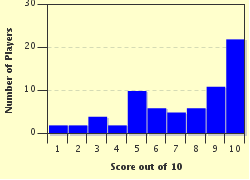Quiz Answer Key and Fun Facts
1. This first German state is home many of Germany's most famous cities including Cologne and Dusseldorf. It borders both Belgium and the Netherlands. It received its name partially from the river that flowers through the state. The Ruhr, a region of highly industrialized cities, is the economic hub of the state and one of the largest in Europe. Which state is this?
2. This state's name is something of a misnomer since it is in the north of Germany and also north of a similarly named state. The city of Hanover is home to the Staatsoper Hanover, a state opera house. Much of this state, including Hanover, was badly damaged by bombs during World War II because it was a center of the oil and rubber industry within Germany. Which state is this?
3. This state is the smallest by area in Germany. It also consists of two separate cities separated by Lower Saxony. One of these cities has the same name as the state. The other is called Bremerhaven, which is an important German sea port on the Weser River. A city in this state is also famous for a traveling band of a donkey, dog, cat and rooster who never actually make it to said city. Which state is this?
4. This southern state is very well known outside of Germany and many things considered quintessentially German originated here. It is an alpine state, home to ski resorts. It would not be unusual to see men dressed in lederhosen while guzzling down a beer in Munich's Oktoberfest. The beer here is governed by the infamous Reinheitsgebot, or German beer purity standards. The BMW automobile company is headquartered in Munich as well. What German state is this?
5. This is the northernmost state in Germany and borders Denmark, the North Sea and the Baltic Sea. Its strategic position on both of these leaves this state as a major trade hub in Northern Europe. Its culture is a mix of German and Scandinavian influences. In 2014, this state gained attention for being the first in Germany to have 100% renewable energy. What state is this?
6. This northeastern state is Germany's least densely populated and home to a lot conservation area. That, however, makes it a popular tourist destination in Germany outside of the big cities. The northern coast is littered with islands while the southern part of the state is covered with lakes. Schwerin Palace in the city of Schwerin is the state's best known work of architecture. What state is this?
7. This region borders three countries, France, Luxembourg and Belgium, in addition to four states. Wine-growing is a large industry here, and this state is Germany's largest exporter of wine. Historically, the Amish people in the United States originated here. What state I am talking about?
8. This landlocked region is bordered by the Czech Republic and Poland. This state is one of the most secular in terms of religion with over 70% of the people being irreligious. During World War II, the city of Dresden was controversially bombed, an act that killed over 25,000 people. Culturally, the city of Leipzig was an important city for famous composers like Richard Wagner and Johann S. Bach. Which eastern state is this?
9. This state is another one that is just a city and a pretty famous city at that. The Rivers Spree and Havel flow through here. It is considered one of the centers of German life, economy and culture. During the Cold War, this city was the center of hostilities and tension between the U.S. and the Soviet Union. At the Rathaus Schoneberg, JFK told the world "ich bin ein Berliner." At the Brandenburg Gate, Ronald Reagan told Mikhail Gorbachev to "tear down this wall". Which city-state is this?
10. This central state is covered with so much forested land that it is nicknamed "the Green Heart of Germany." The city of Eisenach is the birthplace of Johann Sebastian Bach. The Wartburg Castle, where Martin Luther translated the New Testament, is one of the most popular tourist attractions in the state. Which state is this?
Source: Author
Joepetz
This quiz was reviewed by FunTrivia editor
spanishliz before going online.
Any errors found in FunTrivia content are routinely corrected through our feedback system.
